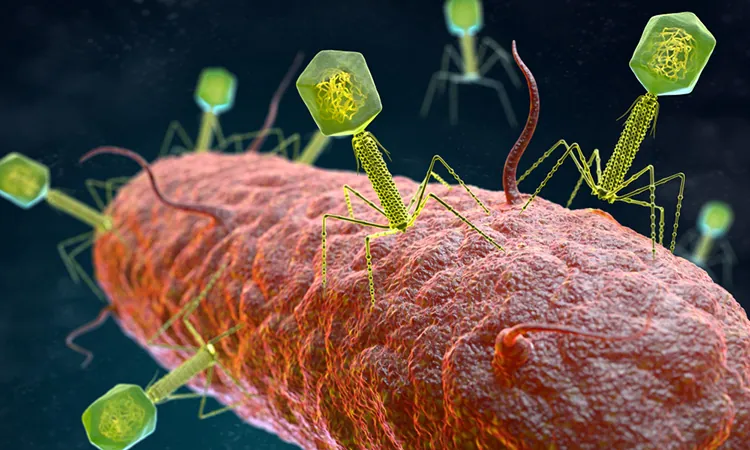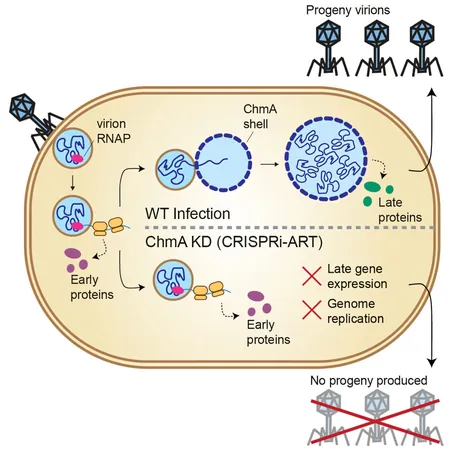
Groundbreaking Research Unveils Bacteria's 'Vaccination' Mechanism Against Viruses
2025-04-01
Author: John Tan
A pioneering study by scientists at Johns Hopkins Medicine has shed light on the remarkable ways bacteria use the CRISPR-Cas system to store viral DNA, effectively enhancing their defenses against future viral infections. This revelation not only deepens our understanding of bacterial immunity but also opens exciting possibilities for the development of phage-based therapies aimed at combating antibiotic-resistant infections.
Just as humans face constant threats from viruses, bacteria are under relentless attack from bacteriophages, often referred to as “phages.” These viral predators can annihilate bacterial cells or, alternatively, enter a dormant phase within them. Understanding how bacteria endure phage assaults is pivotal for scientists as they strive to devise innovative methods to tackle infectious diseases.
In their recent publication in Cell Host & Microbe, the researchers illustrated a fascinating defense mechanism employed by bacteria— they can effectively ‘vaccinate’ themselves using genetic fragments from weakened, dormant phages. This process ensures that future bacterial generations are endowed with the knowledge to recognize and fend off similar viral threats.
Bacteria's Memory of Viral Foes
The investigation was led by Dr. Joshua Modell, focusing on Streptococcus pyogenes, the culprit behind strep throat. His team examined temperate phages, which have a distinct dual nature; they can either destroy bacteria or opt for a dormant existence. During the latter, bacteria seize genetic sequences from these phages, integrating them into their own genome. This ‘genetic memory’ is then passed down through generations, allowing bacteria to swiftly identify and repel subsequent phage encounters.
"This process is quite analogous to receiving a vaccine that contains weakened viruses," remarked Nicholas Keith, a graduate student and the study’s first author.
The Role of CRISPR: Bacteria's Intrinsic Defense Mechanism
At the heart of bacterial immunity is the CRISPR-Cas system, a sophisticated defense tool that functions as a molecular recording device. It captures snippets of viral DNA from earlier assaults, empowering bacteria to recognize and eradicate invaders upon future encounters.
To investigate how bacteria acquire this genetic memory, the researchers conducted experiments involving bacterial populations infected with both natural temperate phages and specially engineered non-dormant phages. They discovered that bacteria excelled at capturing DNA from dormant phages compared to active ones. Through comprehensive genome sequencing, they uncovered hundreds of thousands of new genetic memories secured within the CRISPR-Cas framework.
"Our findings suggest that the CRISPR system's efficiency is significantly heightened when utilizing naturally dormant phages," Modell commented. "In contrast, when we introduced phages that couldn’t switch to dormancy, the CRISPR process struggled."
Health Implications and Future Directions
This study offers crucial insights into how bacteria can acquire dangerous genes from phages, resulting in more virulent strains of pathogens like Staphylococcus aureus (Staph), Escherichia coli (E. coli), and cholera. By understanding bacterial immunity mechanisms, researchers can better design phage therapies that specifically target antibiotic-resistant bacteria.
Dr. Modell elaborated, "CRISPR systems serve as a frontline defense against harmful phage genes that render bacterial cells more pathogenic. Moreover, our findings will significantly influence the design of phage therapies intended for clinical scenarios where traditional antibiotics fail."
Looking ahead, future research will delve into how CRISPR systems defend against viruses that do not enter dormant states, potentially paving the way for groundbreaking medical and biotechnological innovations that could transform how we treat bacterial infections moving forward.
Stay tuned as we explore the implications of this research and what it means for the future of antibiotic resistance and infection control!




 Brasil (PT)
Brasil (PT)
 Canada (EN)
Canada (EN)
 Chile (ES)
Chile (ES)
 Česko (CS)
Česko (CS)
 대한민국 (KO)
대한민국 (KO)
 España (ES)
España (ES)
 France (FR)
France (FR)
 Hong Kong (EN)
Hong Kong (EN)
 Italia (IT)
Italia (IT)
 日本 (JA)
日本 (JA)
 Magyarország (HU)
Magyarország (HU)
 Norge (NO)
Norge (NO)
 Polska (PL)
Polska (PL)
 Schweiz (DE)
Schweiz (DE)
 Singapore (EN)
Singapore (EN)
 Sverige (SV)
Sverige (SV)
 Suomi (FI)
Suomi (FI)
 Türkiye (TR)
Türkiye (TR)
 الإمارات العربية المتحدة (AR)
الإمارات العربية المتحدة (AR)